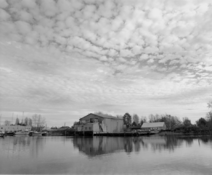Thank you all for sharing your experiences with the tabular grain films. It's fascinating to read the diversity of opinions.
So, Acros II is a newer tabular emulsion, compared to the original ones from the 1980s and 1990s, so why not look at another newer tabular film, the KODAK PROFESSIONAL T-MAX 400 (TMY-2). I have searched for Kodak's characteristic curves, and the most recent I found is from 2016, so it might be for the older TMY film. Still, I think it's nice to be able to compare the two. Looking "by eye," the overall shapes are similar, and Kodak got about the same speed as I did (maybe 1/4 stop more?), though it is hard to tell exactly. Here are the two curves to compare:
Kodak:

My own test (TMY-2):

I think that for a lot of outdoor scenes, TMY-2 can be successfully exposed at EI400, only lowering the EI and cutting development time for scenes of seven stops or more. That's what I typically do, anyway.
@Andrew O'Neill I am working on it. It'll be a few months before the UI is decent enough to show.
@Craig I agree that it is surprising to see the Acros II speed so low. I will, therefore, retest in D-76 and report as soon as it's ready. Thank you for bringing it up!
@Andrew O'Neill I am working on it. It'll be a few months before the UI is decent enough to show.
Thanks! I look forward to it!









 If Matt has an image in his portfolio to share, it means he succeeded getting the result he wanted, otherwise it probably would have been discarded. But was it easy/enjoyable? That's a subjective criteria we can only share anecdotes about.
If Matt has an image in his portfolio to share, it means he succeeded getting the result he wanted, otherwise it probably would have been discarded. But was it easy/enjoyable? That's a subjective criteria we can only share anecdotes about.


